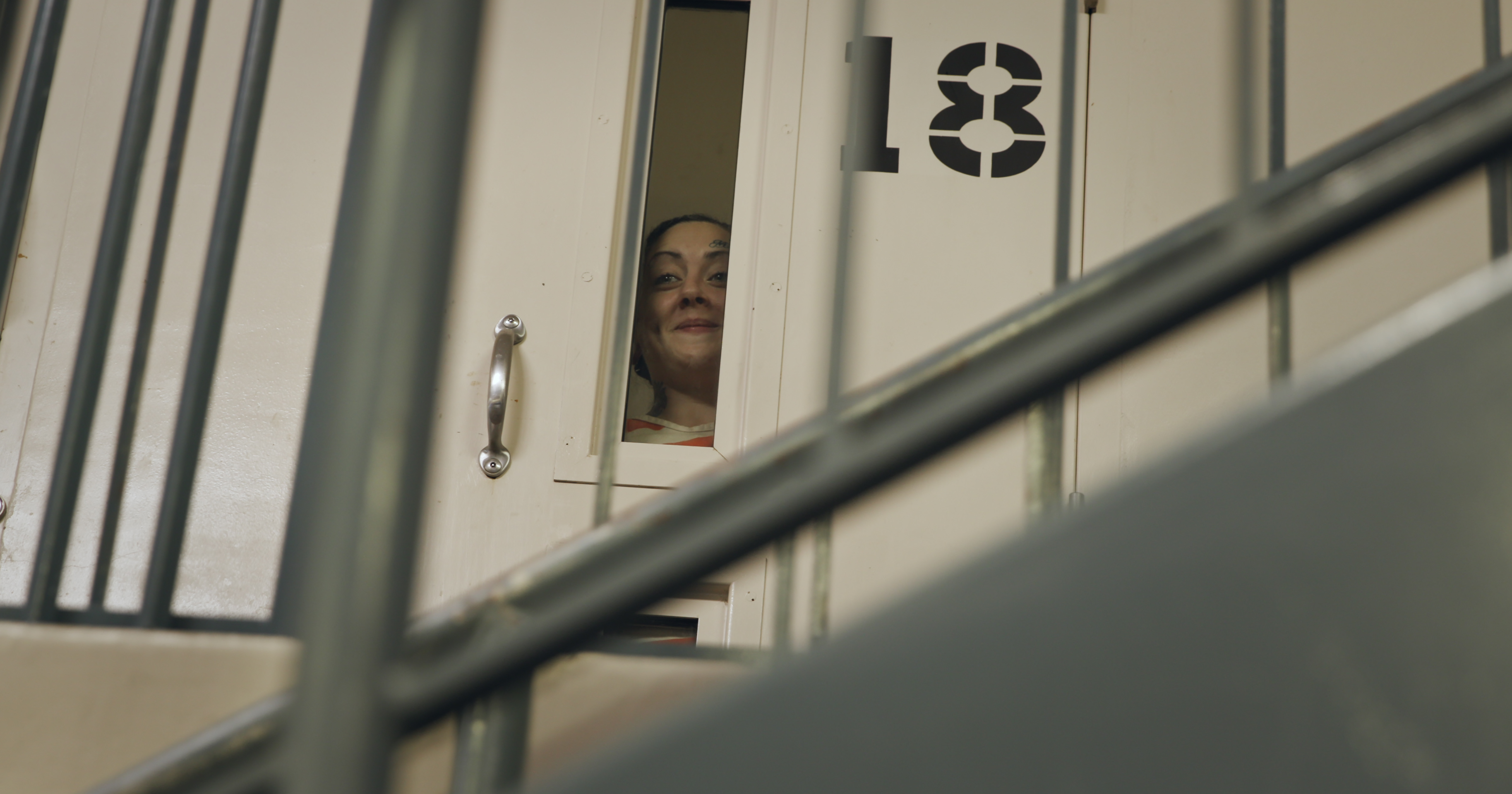Are inmates being exploited for our entertainment?

Megan “Monster” Hawkins. Netflix
I recently asked whether the true crime genre could cause more harm than good for criminal defendants. The reaction was mixed, but most everyone I spoke with in regards to the column mentioned the potential negative impact.
Jailbirds isn’t really true-crime. Even still, the new Netflix series—which focuses on inmates in the Sacramento County Main Jail—potentially presents many of the same unfavorable consequences. Jailbirds feels more like reality television, and it carries with it many of the genre’s biggest flaws.
The six-episode first season doesn’t appear scripted in the same way as many other reality television shows; however, it feels forced at times. The interplay between the “cast” left me with the impression many of the subjects were “acting” for the camera. I was only able to make it through the first three episodes before I concluded that the series is little more than an attempt to capitalize on vulnerable individuals caught in a lose-lose situation.
While Jailbirds offers very little educational value as it relates to the criminal justice system, the small amount of entertainment it supplies comes only at the expense of the inmates and their dignity.
The camera and potential problems for prisoners
First and foremost, I have to wonder how and why the jail allowed such unfettered access to some of its inmates. From the looks of things, a vast majority of the scenes are actually filmed inside specific jail cells. Safety hazards notwithstanding, the camera crews act as an ever-present entity capturing the inmates at their best and worst.
The “cast” appeared at their worst more often than not. Could that be a result of the jail setting? Most likely. After all, we are dealing in large part with criminals. The vast majority of inmates in county jail fit into three categories: poor and sick people who can’t make bond, people charged with crimes so severe they can’t make bond, and people thought to be so dangerous they aren’t allowed bond. Throw in the individuals already sentenced and awaiting transfer, and there is your county jail population.
However, some of the conduct could just be braggadocio for the camera. This is evident in a scene where one inmate attempts to distribute pills to another as she brags about her sexual prowess and flirtatious behavior. The other inmate plays dumb, but as she is continually pushed to take the pills, she finally mentions that there is obviously a microphone right over them.
Some inmates are more worried about the ramifications of their actions. Others don’t seem to care. Multiple women demonstrate on camera how to make “pruno” (jail booze), and one inmate explains how she cons the correctional officers into giving her cold medication so she can craft an intoxicating concoction (which she proceeds to make for the camera and distribute to another inmate).
I don’t know if any of the violations caught on camera resulted in criminal charges. They did, however, result in administrative sanctions that added more time to the inmates’ original sentences. Some might argue that activity occurs with or without a camera crew present. There’s still no reason to glorify it.
Megan “Monster” Hawkins was one of the series’ main characters. She stated in an interview with CBS Sacramento at the time of the Netflix premiere that she was grateful to have participated in Jailbirds; however, she was arrested again within a week. Police said Hawkins was recognized by bank staffers when she to use a fake ID at the establishment. Hawkins denied the accusations in an ABC10 interview. Consequently, even if the violations caught on camera did not lead to additional criminal charges, the notoriety gained by participating in the series has led, at the least, to recognition that could prove problematic.
I like to think that most of the inmates refrained from participating at the advice of the local public defender’s office. There’s really no telling how the depictions of the participants’ deviant behavior impacted potential future charges.
A real-life ‘Orange is the New Black’?
Although 90% of the Sacramento County Main Jail’s population is male, the series focuses almost entirely on the female inmates. If the show was designed as an examination of the effects of incarceration on the female population, that spotlight would present a unique and somewhat original perspective.
But Jailbirds only gives a surface-level treatment to the imamates’ underlying issues. There is likely little coincidence the female inmates and their relationships take center stage. Both the production team and Netflix no doubt have considered Orange is the New Black’s incredible success. Jailbirds likely aims to profit from that same audience.
The episodes I reviewed mainly focused on the positive and negative aspects of these exchanges between the female inmates. Men are rarely discussed (and usually only in relation to the women they are involved with), and most of the relationships the series examines occur between the women. Some are romantic, and others are merely platonic. Regardless, as many of the “cast” members explain, relationships are one of the only things that keep a person sane throughout captivity.
This fact is furthered by the diametrically opposed lives of those inmates in general population and segregation. As one of the first few episodes details, those individuals who have been placed in AD-SEG (administrative segregation) face a painful reality of loneliness and hopelessness. Inmates are placed in segregation either as a result of their charged offense, mental health, or write-ups they have received for violating jail rules.
In one episode, we see an inmate beg to be removed from segregation and placed back into general population. She explains that most of the incarcerated individuals in the segregated pod constantly scream or spend their time talking to themselves. Its moments like this where the production team could have delved into many mental health issues affecting inmates. Instead, the situation is treated as a one-off description, more or less.
Does the series have any redeeming qualities?
I’ve previously written about another Netflix series detailing life in county jail. However, that series (First and Last) tried looking into the problems facing county jails and the inmates who stay there. The depiction was more true-to-life than what is portrayed in Jailbirds.
Still, the series does have some positive elements if you get past the contrived-comedy aspect that rears its head far too often. There is a “jail jargon” section that explains some of the lingo used by the inmates. One episode contains a montage of inmates explaining the somewhat complex calculations that lead to the estimated amount of time they will actually serve on a particular sentence. Still, none of this is informative unless you plan on going to jail or have friends or family who are currently incarcerated.
Strangely, “kites” (toilet notes) and toilet phones are probably what most take away from Jailbirds. The first three episodes go into great detail as to how inmates can communicate between the cells of the tower-like jail through the toilets and plumbing system. Once the commode is drained, it can be used to communicate and send various items of contraband via “fishing” with line and plastic spoons. The practice is ridiculously clever, but it is probably common to all tower-shaped jails … and it often causes flooding.
Therein lies the series in a nutshell: the most compelling aspect is people yelling at each other while their heads are buried in emptied human-waste containers. Even though it’s a common occurrence, is it really something that needs to be filmed and popularized? I don’t think so, and that’s a big reason why I didn’t finish the series.
In an odd way, Jailbirds attempts to glamorize the gritty reality of living in a cage. Hopefully, the show presents its audience with a question: is our love for true crime so strong that we are willing to fall down a slippery slope toward turning captive inmates into pseudo “reality-TV” stars?
Perhaps that is the biggest takeaway.

Adam Banner
Adam R. Banner is the founder and lead attorney at the Law Offices of Adam R. Banner, a criminal defense law firm in Oklahoma City. His practice focuses solely on state and federal criminal defense. He represents the accused against allegations of sex crimes, violent crimes, drug crimes and white collar crimes.
The study of law isn’t for everyone, yet its practice and procedure seem to permeate pop culture at an increasing rate. This column is about the intersection of law and pop culture in an attempt to separate the real from the ridiculous.



